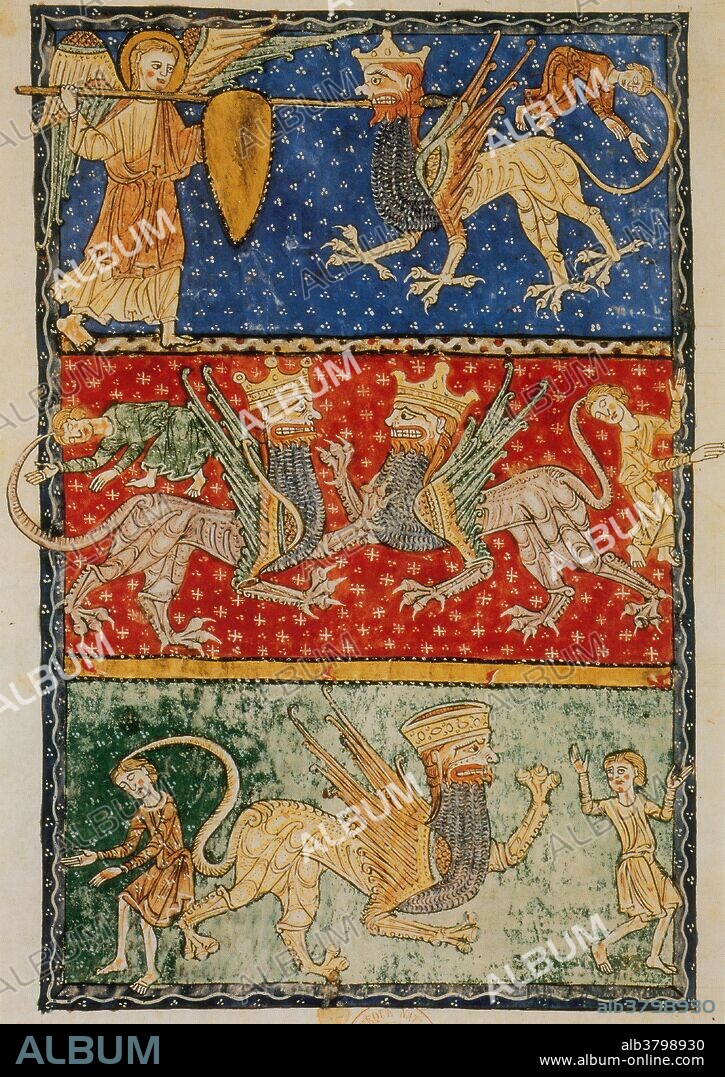alb3798930
Abaddon and Scourge of Locusts, Apocalypse

|
Añadir a otro lightbox |
|
Añadir a otro lightbox |



¿Ya tienes cuenta? Iniciar sesión
¿No tienes cuenta? Regístrate
Compra esta imagen.
Selecciona el uso:

Título:
Abaddon and Scourge of Locusts, Apocalypse
Descripción:
Traducción automática: El ángel del abismo es Abaddon, descrito como una estrella personificada que cae a la Tierra desde el cielo y recibe la llave para abrir el abismo. Abaddon abre el hoyo, liberando un enjambre de langostas. La plaga de langostas se asemeja a caballos con rostros humanos coronados, cabellos de mujer, dientes de león, alas, corazas de hierro y una cola con aguijón de escorpión que atormenta durante cinco meses a cualquiera que no tiene el sello de Dios en la frente. Comentario al Apocalipsis (Commentaria In Apocalypsin) fue una obra del siglo VIII del monje y teólogo español Beato de Liébana. A menudo se le conoce simplemente como el Beato. Los códices Beatus se encuentran entre los manuscritos medievales españoles más importantes y han sido objeto de una extensa investigación de eruditos y anticuarios. Manuscrito iluminado, Beato de San Andrés de Arroyo, 1215
The angel of the abyss is Abaddon described as a personified star who falls to Earth from heaven and is given the key to open the bottomless pit. Abaddon opens the pit, releasing a swarm of locusts.The plague of locusts resemble horses with crowned human faces, women's hair, lions' teeth, wings, iron breast-plates, and a tail with a scorpion's stinger that torments for five months anyone who does not have the seal of God on their foreheads. Commentary on the Apocalypse (Commentaria In Apocalypsin) was an eighth century work by the Spanish monk and theologian Beatus of Liébana. It is often referred to simply as the Beatus. The Beatus codices are among the most important Spanish medieval manuscripts and have been the subject of extensive scholarly and antiquarian enquiry. Illuminated manuscript, Beatus of San Andres de Arroyo, 1215.
Crédito:
Album / Science Source / New York Public Library
Autorizaciones:
Tamaño imagen:
3282 x 4634 px | 43.5 MB
Tamaño impresión:
27.8 x 39.2 cm | 10.9 x 15.4 in (300 dpi)
Palabras clave:
1215 • ANGEL • ANIMAL • ARTE • BATALLA ARMAGEDDON • CHRISTIANITY • COMENTARIO AL APOCALIPSIS • CREATURE • CRIATURA • CRISTIANDAD • CRISTIANISMO • CRISTIANO • CRISTIANSMO • CUENTO POPULAR • DIBUJO • EDAD MEDIA • ESPANOL • FAMOSA • FAMOSO • FOLKLORE • HISTORIA • HISTORICO • HUMANOIDE • ILUMINACION MANUSCRITO • ILUSTRACION • IMAGINARIO • IMPORTANTE • LEGENDARIO • MANUSCRITO ILUMINADO • MANUSCRITO MINIADO • MANUSCRITO • MEDIEVAL • MÍTICO • MITO • MITOLOGICA • MITOLÓGICO • MITOLOGICOS • MONSTER • MONSTRUO • OBRA DE ARTE • RELIGION • RELIGIOSO • REVELACION • S. XIII • SIGLO XIII
 Pinterest
Pinterest Twitter
Twitter Facebook
Facebook Copiar enlace
Copiar enlace Email
Email
